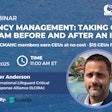Water is an amazing, mysterious and powerful element. To understand the capabilities of water and its effect on swimming pools it is vital to understand how water travels throughout our world. The Water Cycle is a continuous loop of various methods through which water continuously transforms and renews itself.
Water can exist in three forms — as a vapor, a solid or a liquid. So, when you see fog while driving you are seeing water in one of its forms traveling into the atmosphere. As water transforms and travels it is subject to the environment in which it passes. The fog for example rises up from the ground and passes through the surrounding air. As it does it picks up whatever is in the air whether it be smoke, dust or car exhaust.
Snow on the ground can pick up contaminants and bacteria. When the snow melts and turns into liquid those contaminants and bacteria can be transported into a nearby stream and river and even end up in source water.
In Milwaukee in 1993 one of the largest outbreaks of cryptosporidium in drinking water was found to be the result of contaminated snowmelt feeding into Lake Michigan. Water moves about this world in lakes and rivers. It takes the form of ice, snow, fog or rain. It is the great absorber and transporter of whatever it comes in contact with. In today’s world, the challenges of source water contamination in swimming pools can be many.
The Evaporation Problem
There are some studies that suggest that the annual evaporation rate in Southern California ranges from 6 to 8 feet. That means that the entire contents of an average backyard swimming pool can be removed by evaporation in a year. When water evaporates from a swimming pool the water in the pool is changed from its liquid state into a gas or water vapor that travels back up into the atmosphere.
When water vaporizes, only pure water leaves the pool. So, as pure water leaves the pool it also leaves behind more dissolved solids that contribute to Total Dissolved Solids (TDS).
There are two environmental factors that will increase the acceleration of evaporation — temperature and humidity. If you place a pot of water on a table in a cool and humid environment, it could take weeks or months for the water to evaporate. However, if you place that pot on the stove and turn the heat on it will evaporate in a matter of minutes. The more heat the faster evaporation occurs.
When you combine heat with dry air then the water will vaporize more quickly. This is why evaporation is a big problem during times of drought when the air is warmer and drier. This accelerated evaporation during times of drought means that the build up of solids in the pool water will also increase leading to higher TDS, Calcium Hardness and pH. This will mean that more acid will be needed to maintain the proper water balance during these drier hotter days.
Also, as TDS increases the effectiveness of chlorine sanitizer will be reduced. In fact a TDS that is 1500 ppm over the start up water can lead to a 50% reduction in the effectiveness of chlorine as a sanitizer.
Unfortunately, if a state or principality has declared an extreme drought, then draining of pools can be restricted. If the pool can’t be drained and diluted to lower the TDS this means that 50% more chlorine will be needed just to keep a residual of free available chlorine (FAC).
Proactively reducing organic contaminants by weekly shocking and the use of a natural-based polymer clarifier can help to slow the build up of these solids. Also, since phosphates are a part of TDS, using a weekly phosphate removal will help to keep levels lower.
Lower Water Levels
Another problem during drought times is that the groundwater gets used up more quickly. Groundwater is what comes from rain that permeates through the soil and then makes its way below ground through cracks and fissures. During periods of drought as groundwater levels go lower this leads to more contaminants in the source water which can lead to higher total hardness, minerals and metals.
According to the National Groundwater Association (NGWA) about 44% of the United States population gets its drinking water from groundwater. The concentration of metals such as copper and iron increase in deep groundwater. Stain and scale inhibitors and metal sequestering treatments will need to be used particularly in areas with well water.
Also, as groundwater levels drop chloride levels increase from an influx of brackish water. This leads to more particulate and higher dissolved solids. The use of shock treatments and natural polymers to floc and remove these to the filter can help. Nitrates can be a big problem in groundwater as well and that can have a direct effect on free available chlorine FAC in pool water. Nitrates in swimming pool water create chlorine demand that devours FAC levels. Again heavy shocking may help here, but draining and using trucked in water that is free of nitrates would be the best solution in these cases.
The Overnight Change of Make-Up Water
Recently in the East Bay area of Northern California customers began to notice a different odor and taste to their tap water. Complaints began to mount and so the East Bay water municipality responded by letting customers know that due to the severe drought they needed to bring additional water in from the Sacramento River to supplement their current supply.
The officials stated that the water brought in had a different make up from the existing water. In today’s world where water is being imported and exported all over it is possible to have the source water makeup change within hours. In some areas water is trucked in as a supplemental supply from hundreds of miles away where the pH, Total Alkalinity and Calcium Hardness can be drastically different from the local water.
If this water isn’t treated properly it can cause balance issues in the pool. One prime recommendation for pool pros today would be to keep track of the source water by testing from the tap on a regular basis. This will help give a better understanding of how to treat the pool water.
Drought Takeaways:
- In times of drought the saturation of water increases due to low groundwater levels and higher rates of evaporation.
- Restrictions on draining in times of drought can lead to an increased use of chemicals in order to maintain a sanitary condition in the water.
- Evaporation is one of the leading causes of water loss when it is warm and dry.
- Solid or liquid covers can help lower the evaporation rate in pools.
- Water sources can change rapidly during times of drought and source water should be tested regularly during these times.








































